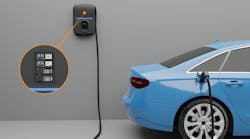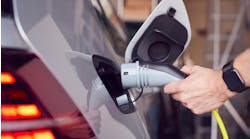The growing adoption of electric vehicles amid the energy transition is creating new avenues of opportunity for electrical contractors to become trusted advisors for homeowners seeking to install electric vehicle (EV) charging infrastructure in single-family homes.
To do this successfully, however, there are important factors contractors need to consider. One is energy capacity, and ensuring the appropriate amount of energy is available to meet charging demands. Another is installing charging infrastructure in a way that positions electrical safety at the top of the priority list.
In the third installment of this four-part series, we’ll look at configuration — specifically, different options for configuring charging infrastructure — and how it can function as a critical opportunity for contractors to enhance customers’ experiences with their EV investments.
The importance of proper configuration
Of all the major considerations for charging installation, a proper configuration allows the contractor to set up the system in a way that fits the unique application for the homeowner’s expected use of their vehicle. This will go a long way toward optimizing the operation of the system and meeting the specific needs of the homeowner.
The first step in any charging installation project is to consult the homeowner and ask the right questions. Some examples of important questions to ask include:
- If they only have one EV, do they plan to add a second?
- How many miles do they anticipate driving every week?
- Are they aware of their electric utility’s rate programs such as time-of-use rates and incentives for EVs related specifically to how the EV charging system should be programmed to minimize the homeowner’s electricity bill?
In general, electrical contractors should advise homeowners to plan for a second EV as doing so will help save time and the cost of additional installation down the road. As they perform more installations over time, electrical contractors should keep a running checklist of commonly asked questions and run through these with the customer before starting each project. This will help them to better understand the customer’s unique needs so they can configure the system accordingly.
Let’s look at different configuration options and considerations, which can be broken into two categories: configuration of physical infrastructure (e.g., the load center, vehicle charger, vehicle cord, and other individual components that make up the system) and the software, which is an important element in optimizing vehicle charging.
Physical configuration considerations
Selecting the type of EV charger will dictate how you move forward with the configuration of the charging system. In a typical residential system, a homeowner can choose between various wall-mount charger options, which include:
- EV wall charger with plug. Install an EV wall charger that plugs directly into a 240V receptacle at a strategic location inside or outside the house. This allows versatility and faster installation. Electrical contractors should ensure adequate ground-fault protection at the outlet level.
- EV wall charger. Hardwire an EV wall charger directly to a load center, located in a similar strategic location. This is ideal for new construction where you can be flexible with wiring and installation of the charger.
Both the EV wall charger and EV wall charger with a plug can include a smart breaker and give homeowners added levels of flexibility and control in addition to enabling them to leverage benefits and features inherent in the charger, such as a mobile control application. This helps follow and manage the charging process.
A final important consideration in physical infrastructure is ensuring compatibility between the charging plug and the EV. Additionally, understanding the homeowners’ expectations for a potential second EV — and configuring the plug accordingly — can help future-proof the system for additional EV purchases.
The J1772, a charging connector that supports most EV manufacturers, cannot only be used with most Level 1 and Level 2 AC chargers but also enables breakout capabilities in EV hardware and software. The exception is Tesla, which developed the North American Charging Standard (NACS) charging connector, the J3400, that is now open for use by other manufacturers — many of which will include the NACS connector as an option starting in 2024. Tesla also includes dedicated plugs that require an adapter to fit a J1772 plug.
Software setup
While effectively configuring the charging hardware is essential to a successful installation and meeting homeowner needs, it’s only the first step.
With extensive digital capabilities built into EV charging infrastructure and opportunities to integrate with smart home energy systems, electrical contractors should work with the homeowner to configure the software in the charger, onboard system, and associated applications to optimize their investment.
Think of this step like setting up a smartphone — while a user can use it to make calls and send texts, doing so is only scratching the surface of its capabilities. Remember, as an electrical contractor setting up EV chargers, you will likely repeat this procedure hundreds of times, but a typical homeowner may only do this once in 10 years. Software can be intimidating for your customers, so try to simplify the more difficult parts of the setup for them. They will greatly appreciate it. Leaving software setup to the homeowner may create confusion, and you will likely be called back for service after the installation. Taking the lead on this part will save you and the homeowner time and money in the long run.
Electrical contractors should familiarize themselves with the ins and outs of charging software and speak to the homeowner about available options that can enhance their experience. At a minimum, this should include aligning the capabilities of the charging infrastructure with the capacity of the onboard system to ensure the vehicle charges at a rate that fits the application. Beyond this, software setup can include configuring capabilities like automated charging that starts at a certain time of night to take advantage of better electrical utility rates or setting charging speed to throttle up or down based on a certain threshold depending on how much the user plans to drive. This can help the user optimize energy costs and ensure they pay only for the energy they need — and do so at the best possible rate offered by their utility.
Charging ahead
As EV adoption continues to grow and more homeowners add EVs to their homes, electrical professionals play a key role in helping homeowners choose the proper charging infrastructure. By communicating with the homeowner and configuring both hardware and software to meet their unique needs, professionals can help set their customers up for charging success for years to come.
About Eaton Experience Centers
At Eaton’s Experience Centers, visitors learn about industry best practices and the latest innovations through hands-on training in multiple application environments. The Eaton Experience Center in Pittsburgh is a full-scale demonstration and testing facility where visitors can see firsthand the latest advances in electrical power quality, energy management, and safety. In this controlled environment, visitors observe product testing and performance, participate in live demonstrations and training courses, and learn about power management technologies from Eaton experts. The goal of Eaton’s Experience Centers is to help take the mystery out of electrical power systems spanning from utility substation equipment to the receptacles in the home. To learn more, visit Eaton.com/Experience.



